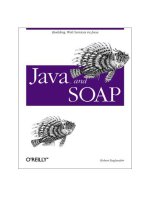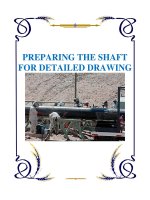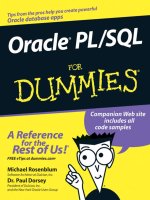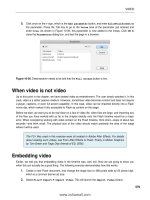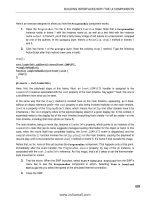Tài liệu Risks and Challenges for Poultry Production doc
Bạn đang xem bản rút gọn của tài liệu. Xem và tải ngay bản đầy đủ của tài liệu tại đây (162.39 KB, 12 trang )
PART 2
Risks and Challenges
for Poultry Production
45
Risks associated with poultry
production systems
L.D. Sims
Asia Pacific Veterinary Information Services, PO Box 344, Palm Cove,
Qld 4879, Australia.
E-mail:
SUMMARY
Every poultry farm has its own risk profile for the introduction of pathogens, subsequent
development of disease, and spread of pathogens to other farms. This risk profile is deter-
mined by a complex interaction between the levels of infection in an area, the measures
implemented on the farm to prevent disease, and other factors including the density of
farms in the area and linkages with other farms and markets. Farm biosecurity measures
reduce, but do not eliminate, the risk of introduction or onward transmission of pathogens;
they include factors such as the location of farms, the physical facilities, and the operational
procedures implemented. Investments in these measures are subject to the law of dimin-
ishing returns. The Food and Agriculture Organization of the United Nations (FAO) has
defined four production systems based partly on the biosecurity measures implemented.
Distinguishing between farms on the basis of the measures practised is important, as not all
intensive poultry production units apply biosecurity measures appropriate to the level of risk
of virus incursion. Experiences with highly pathogenic avian influenza viruses of the H5N1
subtype have shown that farms in all production systems have experienced outbreaks, of
highly pathogenic avian influenza, and that it is not possible to blame one particular system
for the genesis or spread of the disease. Nevertheless, farms that rear ducks outdoors or
where poultry are sold through poorly regulated live poultry markets appear to be high-risk
enterprises, especially in countries where infection is present. Enhancement of biosecurity
measures is generally agreed to be the best way to minimize this risk, but not all farms are
in a position to implement stringent biosecurity, especially those that rely on rearing poultry
outdoors. Formal risk analysis has rarely been applied to individual farms, but would assist
in determining the benefits of existing and proposed on-farm biosecurity measures and in
highlighting gaps in our knowledge regarding the levels of hazard for farms.
Key words: poultry, production, systems, risks, H5N1
Poultry in the 21
st
Century
46
Poultry production and the
environment – a review
P. Gerber, C. Opio and H. Steinfeld
Animal Production and Health Division, Food and Agriculture Organization of the United Nations,
Viale delle Terme di Caracalla, 00153 Rome, Italy
SUMMARY
Over the past decades, the poultry sector’s growth and trends towards intensification
and concentration have given rise to a number of environmental concerns. A direct con-
sequence of these structural changes (industrialization, geographical concentration and
intensification) in poultry production is that far more waste than can be managed by land
disposal is produced, resulting in environmental problems. This paper analyses the environ-
mental impacts arising from intensive poultry production, evaluating such impacts across
the food chain and all environmental media. The paper also presents technical options
to mitigate environmental impacts, such as improvements to farm management, animal-
waste management and nutrition management, along with options to reduce the impacts
of intensive feed production.
Key words: poultry, intensification, future, climate
47
Do old and new forms of poultry
go together?
Jan Slingenbergh
1
and Marius Gilbert
2
1
Animal Production and Health Division, Food and Agriculture Organization of the United Nations,
Viale delle Terme di Caracalla, 00153 Rome, Italy.
2
Biological Control and Spatial Ecology, Université Libre de Bruxelles CP160/12, Av FD Roosevelt 50, B1050
Brussels, Belgium.
SUMMARY
Given conflicting zoosanitary regimes, the question arises whether or not old and new
forms of poultry production may peacefully co-exist in the face of highly pathogenic avian
influenza (HPAI) and other biological threats. Here, we argue that commercial poultry plants
and associated distribution and marketing channels may have to step-up biosecurity and
sanitation efforts in order to halt the evolution of further pathogens that thrive on mass-
rearing of birds in quasi-biosecure conditions. Scavenging poultry, on the other hand, may
be more capable of resisting parasites and infectious disease agents, but it should be noted
that there are a growing number of exceptions, including HPAI and other, mainly RNA,
viruses. Mostly, these pathogens first emerge as virulent agents in large poultry plants.
Conversely, there is evidence that commercial poultry chains are forced progressively to
invest in health protection because the poultry plants are under increasing threat from
microbes circulating freely in nearby village or backyard poultry. Given the rapid evolution
of medium-size systems and live-bird markets, meeting points between old and new forms
of poultry husbandry are on the rise and so are the options for mutually destructive patho-
gen transmissions. Hence, structural reforms are necessary in order to address the growing
health threats present in today’s far too complex poultry circuitries.
Key words: old, new, production, systems
Poultry in the 21
st
Century
48
OIE standards and guidelines
related to trade and poultry
diseases
Christianne Bruschke and Bernard Vallat
World Organisation for Animal Health, 12, Rue de Prony, 75017 Paris, France.
SUMMARY
Recognizing the difficulty faced by some countries in fully eradicating animal diseases
from their territories as a whole, or to maintain animal disease-free status in parts of their
national territories, the World Organisation for Animal Health (OIE) has introduced the
concepts of zoning and compartmentalization for purposes of disease control and interna-
tional trade, in the Terrestrial Animal Health Code. Compartmentalization is based mainly
on functional separation by biosecurity measures, whereas zoning is based mainly on geo-
graphical separation. Relevant animal subpopulations should be clearly defined, recogniz-
able and traceable, and should be epidemiologically separated from other subpopulations.
Veterinary authorities as well as the private sector have important responsibilities in the
establishment and maintenance of compartments.
Key words: OIE, standards, guidelines, compartmentalization, zoning
49
Animal welfare in poultry
production systems: impact of
European Union standards on
world trade
P.L.M. Van Horne* and T.J. Achterbosch
Agricultural Economics Research Institute (LEI), Wageningen University and Research Center (WUR),
P.O. Box 29703, 2502 The Hague, The Netherlands.
*Corresponding author:
SUMMARY
Animal welfare receives more legislative attention in the European Union (EU) than in many
other regions of the world. Animal welfare standards for poultry are generally taken to be
higher in the EU than in producing countries exporting to the EU, particularly developing
countries. The recent action plan for animal welfare introduced by the European Commis-
sion aims to further expand the body of regulatory standards.
In broiler production worldwide, birds are kept on deep litter. Recently, the EU agreed
on a new directive to set maximum standards for bird density. However, this is not consid-
ered likely to have a great impact on global trade. At present, the difference between Brazil
and Thailand and the EU in terms of animal conditions, including bird density, is limited.
In egg production, the majority of commercial layers are kept in battery cages. There is
wide variation in space allowance per bird from 300 to 400 cm
2
in Brazil, Ukraine or India to
the current 550 cm
2
per hen in the EU. After 2012, hens in the EU will be kept in enriched
cages with a minimum space allowance of 750 cm
2
per hen. It can be expected that this
will have an impact on world trade in egg products and especially egg powder. Trade in
table eggs will continue to be limited to within regions.
The EU is considering the use of labelling to provide consumers with more information
concerning the standard of production. Another option could be to use financial mecha-
nisms such as taxes or tariffs. The likelihood that a measure is challenged depends on how
difficult it is for exporters outside the EU to meet the requirements.
Keywords: poultry production, animal welfare, economics, international trade
Poultry in the 21
st
Century
50
Zoonotic disease risks and
socio-economic impacts of
industrial poultry production:
review of the experience with
contract growing in the United
States of America
Jessica H. Leibler,
1
Joachim M. Otte,
2
and Ellen K. Silbergeld
1
1
Johns Hopkins Bloomberg School of Public Health, Department of Environmental Health Sciences, Baltimore, MD
United States of America.
2
Animal Production and Health Division, Food and Agriculture Organization of the United Nations,
Viale delle Terme di Caracalla, 00153 Rome, Italy.
SUMMARY
The model of food animal production in the United States of America, which is character-
ized by an industrial scale and organization, is currently expanding globally, particularly in
Asia. The practice of contract poultry growing, in which firms contract out the raising of
live chickens to independent farmers, is often a key component of this system. The poultry
industry in the United States of America is highly vertically coordinated, and contract grow-
ing within this coordinated system reduces economic risk and costs to the firm (known as
the integrator), and to some extent to the growers as well by providing the growers with
market access for their products. However, contract growers assume the burdens of many
of the costs as well as the negative health and social externalities of poultry production,
including waste management, occupational and community health risks, implementation
of farm-level biosecurity and socio-economic decline. The disparity in economic power
between integrator and grower allows the integrator to outsource these externalities onto
the grower, and exclude these negative by-products from their costs of production. In light
of concerns regarding emerging zoonoses, particularly pandemic influenza, the potential
consequences of this system for global public health are significant. A full understanding of
experience in the United States of America with respect to the implications of the zoonotic
disease risks and economic impacts associated with contract growing can inform policies
aimed at reducing these risk factors in nations where the private sector is increasingly
adopting a contracting model.
Key words: poultry, United States of America, model, contract
51
Response of the Thai poultry
industry to highly pathogenic
avian influenza
Anan Sirimongkolkasem
President of the Thai Broiler Processing Exporters Association.
SUMMARY
Significant markets remain much the same as they were before highly pathogenic avian
influenza (HPAI). Thai producers are continually adjusting their marketing strategies. Fol-
lowing the severe HPAI outbreaks of 2003, government stepped in to regulate processing
plants through certification programmes. Despite these measures, only half of the existing
plants managed to meet the required standards and producers had to adjust their strate-
gies. Adjustment in the private sector is far from easy and requires significant investment
in equipment. Skilled labour, however, is one of Thailand’s strong points. A cooked-meat
customer base is essential for industry survival, and the Thai industry has been successful
in meeting customer needs. Thailand will continue to increase exports of cooked chicken
meat.
Key words: Thailand, poultry, export, HPAI
Poultry in the 21
st
Century
52
Food-safety concerns in the
poultry sector of developing
countries
Jenni Kiilholma
Animal Production and Health Division, Food and Agriculture Organization of the United Nations,
Viale delle Terme di Caracalla, 00153 Rome, Italy.
SUMMARY
Poultry production is one of the fastest growing livestock industries as a result of its advan-
tages in terms of land use and improvements in the food conversion rate of genetically
superior poultry breeds. Among the major concerns related to this development are health
issues threatening not only animal production, but also the people using the products
derived from these animals. Microbiological risks, such as salmonella-related food poison-
ing, pesticide residues from feed production, and resistance problems following the use of
antibiotics in animal production have become the focus of attention.
In the industrial world, legislation and regulations have been implemented, involving
both the public and the private sectors. However, in many developing countries such meas-
ures do not exist. Food-borne illnesses are, therefore, still major problems in developing
countries. This paper discusses the measures that can and should be taken by develop-
ing countries to ensure safe products from the poultry sector. Examples are given from
Bangladesh. As production conditions vary greatly as a result of socio-economic, political
and environmental factors, regulations applied in one part of the world may not be suit-
able elsewhere. It is also questionable whether a developing country that does not aim
to enter the export market for poultry, or livestock products in general, should apply the
same standards as an exporting country. Many countries only produce for their national
markets and therefore lack the incentive to follow international regulations; approximately
90 percent of global livestock products are sold in domestic markets. Nevertheless, the
prevalence of food-borne diseases in developing countries is alarmingly high, and action
is needed especially with regard to consumer awareness. To achieve this, there is a need
for more information to be gathered about the conditions in individual countries, and for
country-specific political action.
53
Risks caused by bio-aerosols in
poultry houses
J. Hartung and J. Schulz
Institute of Animal Hygiene, Welfare and Behaviour of Farm Animals, University of Veterinary Medicine Hannover,
Bünteweg 17p, 30559 Hannover, Germany.
E-mail:
SUMMARY
Aerial pollutants in confined animal houses are widely recognized as detrimental to the
respiratory health of animals kept in these facilities. Primary and opportunistic microbial
pathogens may directly cause infectious and allergic diseases in farm animals, and chronic
exposure to some types of aerial pollutants may exacerbate multi-factorial environmental
diseases. There are, however, few international field surveys paying attention to the health
of the farmers and the farm personnel working in such atmospheres, and to the spread of
pathogens from farm buildings. Studies reveal that up to 20 percent of farmers and farm
workers report work-related symptoms of respiratory affections, such as coughing, sputum
and wheezing. Some develop asthma, others develop diseases that are described as ODTS
(organic dust toxic syndrome). There are indications that various pathogens can survive in
ambient air for several minutes and can be distributed over long distances, (e.g. foot-and-
mouth disease (FMD) virus more than 50 km, and staphylococcae up to 500 m).
This paper describes the complex nature and composition of the aerial pollutants, such
as gases, dust, micro-organisms and other compounds, present in the air of farm animal
houses, their potential role in the development of respiratory diseases in humans and ani-
mals, and their distribution in the surroundings of farms. Future-oriented sustainable farm
animal production should (in addition to improving animal welfare, consumer protection,
economy and occupational health) enhance standards aimed at preventing or reducing the
aerial spread of pathogens.
Key words: air pollutants, bio-aerosols, poultry farming, disease transmission, occupa-
tional health, dust, gases, bacteria
Poultry in the 21
st
Century
54
Veterinary services for poultry
production
Karin Schwabenbauer and Jonathan Rushton
Animal Production and Health Division, Food and Agriculture Organization of the United Nations,
Viale delle Terme di Caracalla, 00153 Rome, Italy
SUMMARY
The current highly pathogenic avian influenza (HPAI) crisis has brought poultry produc-
tion to the focus of public attention. Poultry production takes place in two basic systems:
the industrial sector and the small-scale production system at village level. The level of
involvement of veterinary services differs greatly between the two systems. While private
veterinary services are important in the industrial sector, there is only limited provision of
veterinary services in small-scale production systems. This has consequences for the success
of disease control measures.
As HPAI is a zoonotic disease, its control is undoubtedly a public good and ultimate
responsibility for this should lie with the official veterinary services. However, as both public
and private sectors are contributing to disease control, this paper suggests strengthening
national animal health systems and ensuring that all service providers have clearly defined
roles and responsibilities under the leadership of the official veterinary services. Evidence
gained during Newcastle disease control projects at village level, indicates that a paradigm
shift in disease control is needed, promoting strong involvement of communities in policy
development. This requires a multidisciplinary approach that enables a better understand-
ing of this specific sector to be obtained. The Food and Agriculture Organization of the
United Nations (FAO) is implementing pilot projects in different countries to better under-
stand virus spread, value chains, the role of poultry in livelihoods, and the species and
breeds kept. Broader knowledge, will allow the impact of control measures in this sector to
be assessed, and national HPAI preventive and control policies to be adjusted as needed.
Key words: disease control, poultry, multidisciplinary, small scale
55
Risks and opportunities for
poultry production
SUMMARY OF DISCUSSIONS
The threat posed by highly pathogenic avian influenza (HPAI) gave rise to numerous
comments. Particularly emphasized were the challenges of ensuring communication and
cooperation among stakeholders (particularly across the dividing line between human and
animal health) and of developing effective strategies for small-scale production systems and
for locations where the infrastructure for disease control is inadequate. It was noted that
inappropriate media coverage of HPAI can sometimes present a problem for those work-
ing on the control of the disease. Cooperation between the public and private sectors was
considered to be essential for effective disease control, and some positive developments in
this area were mentioned. It was also noted that there are lessons to be learned from the
control of other diseases such as Newcastle disease. Communication among all stakehold-
ers, including the consumers, was emphasized as a means to foster trust and openness. The
need to clarify the role of vaccination in the control of HPAI was noted, as was the need
for a better understanding of the roles of wild birds and the transport and trade of poultry
in the spread of the disease.
The future of small-scale poultry production was also discussed. Its important contribu-
tion to the livelihoods of the poor was recognized, as were the challenges of controlling
diseases such as HPAI in this production system. It was noted that there is a need to learn
more about the livelihoods and priorities of poor poultry keepers – without this understand-
ing, attempts to introduce new technologies would have little impact in terms of poverty
reduction. There was a call for improvement of community-based animal health systems,
backed by adequate training and community participation in the financial aspects of such
schemes. The need to develop effective early-warning systems at the community level was
noted.
With regard to the environmental impacts of poultry production, it was argued that
the real problem is not a lack of technologies to deal with the problems, but the costs of
implementing them and a lack of incentives and regulations to enforce their use. It was also
suggested that pollution costs and other externalities should be taken into account when
assessing the relative efficiency of different production systems.
Other challenges brought up during the discussion included food safety, changing con-
sumer demands (possible future increase in consumer demand for breast meat in develop-
ing countries), rising input costs, the use of feed crops for biofuel production, and loss of
genetic diversity in the poultry population.


